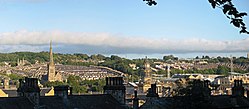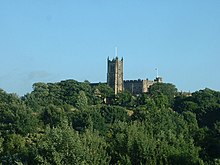Lancaster
| Lancaster | |
| Lancashire | |
|---|---|
 Skyline of Lancaster from Lancaster Castle | |
| Location | |
| Grid reference: | SD475615 |
| Location: | 54°2’49"N, 2°48’4"W |
| Data | |
| Population: | 45,952 (2001) |
| Post town: | Lancaster |
| Postcode: | LA1 |
| Dialling code: | 01524 |
| Local Government | |
| Council: | Lancaster |
| Parliamentary constituency: |
Lancaster and Fleetwood |
Lancaster is the county town of Lancashire. It stands on the River Lune and has a population of 45,952.
Lancaster is the most northerly city in Lancashire, located three miles inland from Morecambe Bay. The city is located on the River Lune and the Lancaster Canal.
With its history based on its port and canal, Lancaster is an ancient settlement, dominated by Lancaster Castle.
Long existing as a commercial, cultural and educational centre, Lancaster is the settlement that gives Lancashire its name. Lancaster has several unique ties to the monarchy; the House of Lancaster was a branch of the English royal family, and the Queen is the Duke of Lancaster; the Duchy of Lancaster and its estates have been preserved as separate from the Crown since the days of Henry IV and holds large estates. Lancaster was granted city status in 1937 for its "long association with the crown" and because it was "the county town of the King's Duchy of Lancaster".
The name of Lancaster comes from that of its river, the Lune, which gives its name too to Lonsdale through which dale the river flows from the hills to the city. The earliest name for the town on this site s not known, but a broken Roman milepost hereabouts indicates “Lon-“ and has lost the rest of the name. That it stood in Anglo-Saxon times is accepted, but the first written record of Lancaster is in the Domesday Book of 1086, as Loncastre and Chercaloncastre (Church-Lancaster).
History


Little is known about Lancaster between the end of Roman rule in Britain in the early 5th century and the Norman Conquest in the late 11th century. Despite a lack of documentation from this period, it is likely that Lancaster was still inhabited. The city's name, first recorded in the Domesday Book in 1086 as Loncastre means 'city on the Lune', from the Old English cæster.[1]
Lancaster Castle, partly built in the 13th century and enlarged by Elizabeth I, stands on the site of a Roman garrison. Lancaster Castle is well known as the site of the infamous Pendle witch trials in 1612. It was said that the court based in the castle (the Lancaster Assizes) sentenced more people to be hanged than any other in the country outside of London, earning Lancaster the nickname, "the Hanging Town".[2]
The traditional emblem for the House of Lancaster is a red rose, the red rose of Lancaster, similar to that of the House of York, which is a white rose. These names derive from the emblems of the Royal Duchies of Lancaster and York in the 15th century. The civil war between the two houses, over claims to the throne, were named by the Victorians the "Wars of the Roses".
In more recent times, the term "Wars of the Roses" has been applied to rivalry in sports between teams representing Lancashire and Yorkshire, not just the cities of Lancaster and York. It is also applied to the Roses Tournament in which Lancaster and York universities compete every year.[3]
Lancaster gained its first charter in 1193[4] as a market town and borough, but was not given city status until 1937.[5] Many buildings in the city centre and along St. George's Quay date from the 19th century, built during a period when the port became one of the busiest in the British Isles; the fourth most important in Britain's slave trade.[6] However, Lancaster's role as a major port was short lived, as the river began to silt up.[4] Morecambe, Glasson Dock and Sunderland Point served as Lancaster's port for brief periods. Heysham now serves as the district's main port.
Lancaster is primarily a service-oriented city. Products of Lancaster include animal feed, textiles, chemicals, livestock, paper, synthetic fibre, farm machinery, HGV trailers and mineral fibres. In recent years, a high technology sector has emerged, as a result of Information Technology and Communications companies investing in the city.
Churches

Lancaster is within the Diocese of Blackburn. Churches include:
- Church of England:
- Christchurch
- Lancaster Priory – The Priory Church of St Mary
- St Thomas
- Baptist:
- [Independent Evangelical:
- Methodist:
Culture

Lancaster, as a historic city, offers an unusual level of contemporary cultural activity. The city is fortunate to have retained many fine examples of Georgian architecture. Lancaster Castle, the Priory Church of St. Mary and the Edwardian Ashton Memorial are among many sites of historical importance.
The Lancaster Grand Theatre and Duke's Playhouse are two of the city's most notable venues for live performances. Lancaster also hosts 'The Play in the Park', a series of open-air performances in the award-winning Williamson Park. The university has the Nuffield Theatre, with the largest student theatre stage in Europe, which regularly attracts big name comics, dance companies and dramatic productions. The Storey Gallery is a contemporary art gallery showing work by international artists. Lancaster also offers numerous museums, including Lancaster City Museum, Maritime Museum and Judges' Lodgings Museum. Throughout the year, various festivals are held in and around the city, such as the Lancaster Jazz Festival and The Maritime Festival.
Cinemas in Lancaster are the independent Dukes Theatre and the mainstream multiplex in the city centre. The 1930s art deco Regal Cinema closed in 2006.[7]
Lancaster has a large arts community.[8][9]
Every November the city hosts one of the biggest fireworks displays in Lancashire.
Media

The Bay, the largest radio station in North Lancashire and Westmorland, is based at St. George's Quay in the city and broadcasts on three separate frequencies: 96.9 FM (Lancaster), 102.3 FM (Windermere) and 103.2 FM (Kendal). The city also has a community radio station, Diversity FM, with a five-year licence from 2006. The community led project is based at the local YMCA. The station includes a variety of shows including one presented by a 5-year-old and one broadcast in the Polish language.[10][11]
Commercially available newspapers include The Lancaster Guardian (a popular tabloid, having changed from broadsheet in May 2011) and The Visitor (a tabloid newspaper mainly targeted at residents of Morecambe). Freely-available newspapers in Lancaster include The Reporter and, previously, The Lancaster & Morecambe Citizen, which ceased production in January 2009.
The city's university, Lancaster University, also has its own student radio station, Bailrigg FM, broadcasting on a signal of 87.7 FM, and an online student-run television station called LUTube.tv.
Places of interest


 Lancaster Castle
Lancaster Castle Lancaster Priory
Lancaster Priory Lancaster City Museum
Lancaster City Museum- Lune Millennium Bridge
- Williamson Park
- Ashton Memorial and Butterfly House
 Lancaster Cathedral
Lancaster Cathedral- The Music Room, Sun Street
- Storey Gallery
 The Judge's Lodgings
The Judge's Lodgings The Cottage Museum
The Cottage Museum- Lancaster University's Ruskin Library
- Penny's Hospital almshouses
- Lune Millennium Bridge
- Penny's Hospital, 18th century almshouses on King Street
 Quayside Maritime Museum
Quayside Maritime Museum- Lancaster Royal Grammar School
- Lancaster Girls' Grammar School
- Duke's Playhouse
- The Gregson Centre
- Lancaster Grand Theatre
- Dalton Square: Queen Victoria's statue and the town hall
- Westfield War Memorial Village
Picture gallery
-
A typical Lancaster city scene
-
Looking down North Road
-
Signposts
References
- Notes
- ↑ Ekwall, Eilert 'The Concise Oxford Dictionary of English Placenames' (1960), 4th edition, p285
- ↑ Lancaster Castle
- ↑ Students Celebrate as Lancaster Triumphs in War of The Roses
- ↑ 4.0 4.1 TIMELINE: Lancaster
- ↑ Former Mayors of the City of Lancaster
- ↑ Cato, Johns - The Slave Trade
- ↑ [1].
- ↑ Virtual Lancaster's "What's on"
- ↑ Studio Arts Events and Exhibitions
- ↑ News and Views - Issue 91
- ↑ Virtual Lancaster - News Archive: 1 – 15 November 2007
- Bibliography
- White, Andrew (2001). "Continuity, Charter, Castle and County Town, 400–1500". A History of Lancaster. Edinburgh: Edinburgh University Press. pp. 33–72. ISBN 0-7486-1466-4.
Outside links
| ("Wikimedia Commons" has material about Lancashire Lancaster) |
- Tourist information website
- Lancaster Fireworks]
- Lancaster City Council – Homepage of Lancaster City Council
- Ordnance survey map of Lancaster circa 1890
- Alternative guide to Lancaster A4 pdf to print out – includes map.
- Lancaster and Morecambe Citizen – Lancaster and Morecambe Citizen newspaper, news and sport updated daily.
- Lancaster Guardian – A weekly newspaper and local resource.
- Virtual Lancaster – Independent Lancaster news and resources.
- Lancaster in pictures – Photos of Lancaster and its university.
- Official Lancashire Tourist information
| Cities in the United Kingdom |
|---|
|
Aberdeen • Armagh • Bangor (Caernarfonshire) • Bangor (County Down) • Bath • Belfast • Birmingham • Bradford • Brighton and Hove • Bristol • Cambridge • Canterbury • Cardiff • Carlisle • Chelmsford • Chester • Chichester • Colchester • Coventry • Derby • Doncaster • Dundee • Dunfermline • Durham • Ely • Edinburgh • Exeter • Glasgow • Gloucester • Hereford • Inverness • Kingston upon Hull • Lancaster • Leeds • Leicester • Lichfield • Lincoln • Lisburn • Liverpool • City of London • Londonderry • Manchester • Milton Keynes • Newcastle upon Tyne • Newport • Newry • Norwich • Nottingham • Oxford • Perth • Peterborough • Plymouth • Portsmouth • Preston • Ripon • Rochester • Salford • Salisbury • Sheffield • Southampton • St Albans • St Asaph • St David's • Southend-on-Sea • Stirling • Stoke-on-Trent • Sunderland • Swansea • Truro • Wakefield • Wells • Westminster • Winchester • Wolverhampton • Worcester • Wrexham • York |



